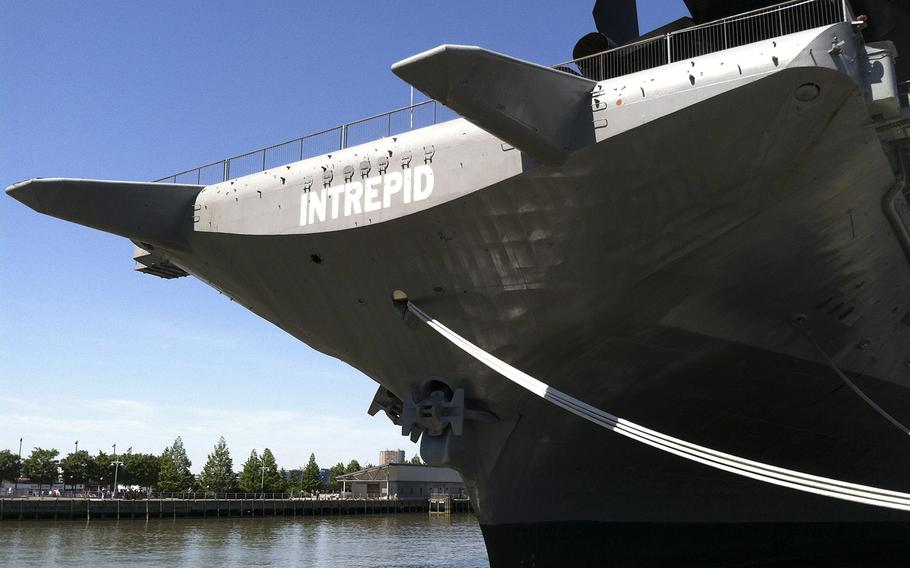
The USS Intrepid in 2012 in New York City, where it's now a floating museum. (Stars and Stripes)
SAIGON — The oldest aircraft carrier in the U.S. Navy's 7th Fleet, the USS Intrepid, celebrated her 25th anniversary as she plied the Tonkin Gulf off the coast of North Vietnam.
Commissioned Aug. 16, 1943, the 42,000-ton carrier continues to live up to its nickname, the "Fighting I."
The history of the Intrepid is one of character, of victory — and death— in battle.
Six days before the Japanese attacked Pearl Harbor, the keel of the Intrepid was laid at Newport News, Va. Nineteen months later, this aircraft carrier the length of three football fields joined the Central Pacific Forces.
Intrepid's battle record began Feb. 4, 1944, with the attack on the Marshall Islands. In her first action, the new carrier's aviators flew against the key assault point of Kwajalein Atoll.
Twelve days later, the ship took her first casualties. Her aircraft were striking Truk Island in the Carolines when Japanese torpedo planes appeared. One of the torpedos blasted into the carrier's starboard side, tearing a gash in her hull. Five men were killed and 11 others lost.
The damaged carrier steamed toward Pearl Harbor, for repairs. Three months later she was back in fighting condition.
By the end of World War II, Intrepid's gunners were credited with destroying 13 enemy planes and assisting in the destruction of five others. Her air groups shot down 160 enemy planes and destroyed 86 on the ground. The carrier was also credited with sinking eleven ships and damaging 41 more.
Her activity was reduced during the immediate postwar period.
With guns and machinery weatherproofed, her status was changed to "out of commission in reserve" in 1947. Five years later, the carrier was transferred from San Francisco to the East Coast.
In the two years that followed when the Intrepid relinquished her reserve status, the carrier became the first ship to launch planes with an American-built steam catapult.
Intrepid underwent a modernization period at the Brooklyn Navy Yard in late 1956. By the end of April 1957, she was equipped with a new angle deck and mirror landing system.
In 1962, after having spent tours in the Atlantic, Mediterranean and Caribbean, the Intrepid became the primary recovery ship for Project Mercury.
Astronaut Scott Carpenter and his ''Aurora 7" space capsule had splashed down 230 miles from the closest surface recovery vessel, so Intrepid's helicopters were sent to make the pickup.
During March 1965, the carrier was again designated the primary recovery ship — this time for the first manned Gemini space flight. She recovered astronauts Virgil Grissom and John W. Young just 74 minutes after their splash down.
The Intrepid entered the South China Sea on May 4, 1966, and made her way to "Dixie Station" off the coast of South Vietnam. For the first time since World War II, the carrier was to launch attacks against an enemy force.
Attack Carrier Air Wing 10, the same air wing that had served with the Intrepid in combat over 20 years before, launched the ship's first strikes against Viet Cong concentrations May 15. Later, the carrier became a part of the Yankee Station team, massing air attacks against the north.
Once, four of her propeller-driven Al Skyraiders were jumped by North Vietnamese Russian-built MiG21s. In the dogfight that followed, the A1s killed one MiG, damaged another and sent the rest fleeing. The Skyraiders returned to the flight deck unscathed.
In 1967, the Intrepid nosed out of Norfolk for her second deployment to Vietnam. She was delayed for several days in the eastern Mediterranean by the Israeli-Arab confrontation but finally passed through the Suez Canal June 1 — the last American warship to use the canal before the outbreak of war.
Now the Intrepid is on her third deployment to Vietnam — an unprecedented record for an Atlantic Fleet carrier.
She celebrated a quarter-century of service in the Navy August 16. She is old, but her record in Vietnam has matched her success in World War II. In three deployments to Vietnam in three consecutive years, the Intrepid has mounted over 20,000 missions against the enemy, bringing a rain of destruction to his bridges, highways, anything that is a threat to the south.
By today's supercarrier standards the Intrepid is small and old. But she and her men are still proud.
''There is no question about the fact that this ship gives the big ones a real run for their money," said Adm, T. H. Moorer, chief of Naval operations, on a recent visit to the carrier, "and when one walks around the flight deck and throughout the ship and talks to the personnel, it is very easy to see the reason why."
The pride that the officers and men have in their ship comes with her age as well as her history. The Intrepid's skipper, Capt. Vincent F. Kelley, compared the carrier to a classic automobile. It has to be given special attention, and through that special attention, it almost becomes a part of the individual.